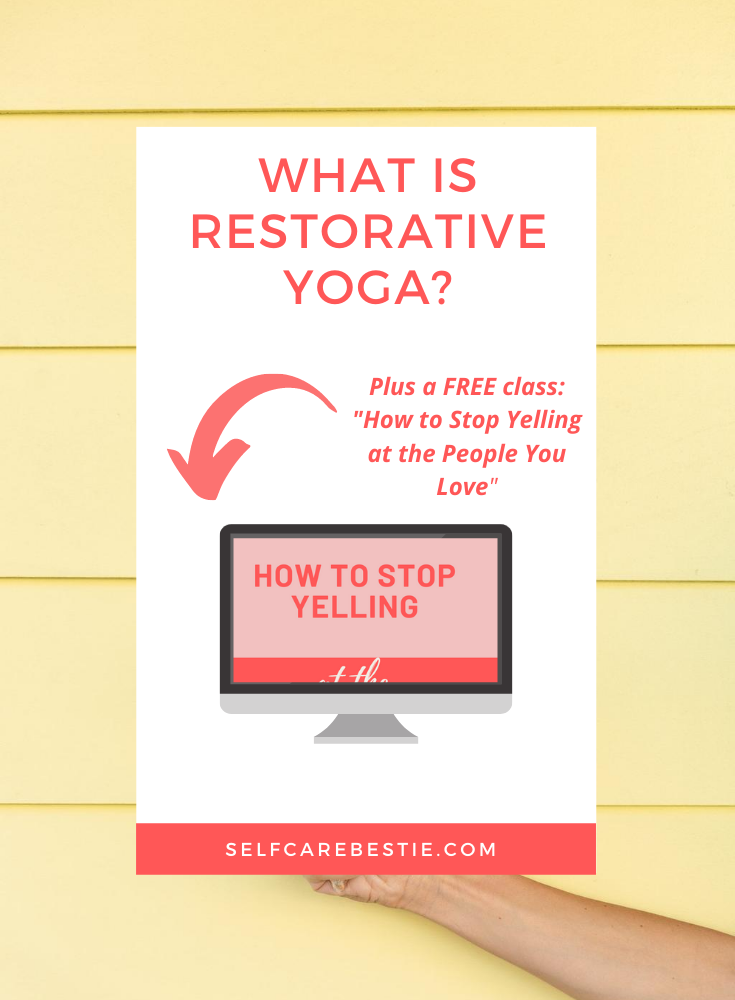
What is restorative yoga?
Restorative yoga is a type of yoga I’m just learning about, even though it’s nothing new to most seasoned yogis, of which, I would definitely NOT consider myself one.
However, I do love yoga. And whenever I practice it, I’m always so glad I did!
The goal of restorative yoga is to activate the parasympathetic nervous system, which promotes your relaxation response. Sound good? Yeah, I thought so!
By activating the parasympathetic nervous system, you can decrease stress, anxiety, and overwhelm. The body and the mind are so very connected; when you successfully activate the parasympathetic nervous system, you can literally take your body from the “fight or flight” response to what is called the “rest and digest” state, or a state of relaxation and, well, chill, for lack of a better word.
While there are many ways to activate the parasympathetic nervous system and achieve this ever-elusive chill state, let’s talk more about the how-tos of restorative yoga.
How to practice restorative yoga
To get the body and mind healing effects of restorative yoga, you’ll need someone to guide you through a practice – and since, as I write this, we are still in the midst of a pandemic, I’m linking to 5 amazing practices I found online so you can start today, from the comfort of your home sweet home:
Restorative Yoga Class (no props needed)
20 Minute Restorative Yoga
40 Minute Self-Care Restorative Yoga Practice
Oceanside Restorative Yoga
Deeply Relaxing Restorative Yoga (20 Minutes)
Once it’s safe to venture back out into the world of group classes, you can simply search for restorative yoga classes near you, or use an app like Class Pass to help you find one! In pre-Covid days, I had my eye on a class near me that offered candlelit restorative yoga and I’m so bummed I didn’t jump on that train when I had the chance…maybe it’ll be my 2021 New Year’s resolution 😉
Helpful things to know before you begin
Restorative yoga differs from many other types of yoga practice in its use of props. You may find yourself using rolled up blankets, yoga blocks (foam, wood, or cork blocks used to help you maintain body positions), eye pillows, yoga mats (obviously), and even essential oils. It may be a little extra work setting up your practice before you start, but trust me, it will be sooo worth it!
Restorative yoga focuses on sloooowww movements. You’ll really want to set an intention before your practice begins to mindfully present for each movement of your body. It’s almost as if you were moving through water, or doing tai-chi-type movements.
Finally, restorative yoga usually involves a minimal number of poses that you’ll hold for a much longer time than other types of yoga. This allows you more time to focus on how each pose feels in every part of your body, and allows your mind to slow down (noticing a pattern??) and be present with each pose, not worrying so much about what’s coming next, or you know, your to-do list for tomorrow.
If you try restorative yoga, I’d love to hear all about it! Tell me what you think – I’m definitely going to be incorporating it into my nighttime self-care when I can. I think it’ll be perfect for those nights when I want to take a bath before bed, but I’m feeling a little too tired or lazy to wait for the water to run! I almost feel like restorative yoga is like a soothing bath without the water – ahh, I can almost hear the Enya playing in the background now…
+ show Comments
- Hide Comments
add a comment